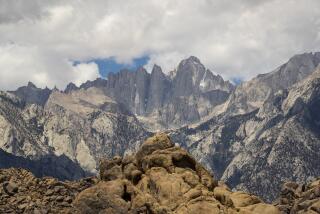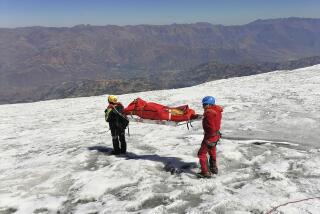Look Back at Life on the Mountain : Chronicling Ups and Downs of 10 Weeks on Mt. Everest
In 1924, British mountaineers George Mallory and Andrew Irvine disappeared after being spotted just 900 feet below the summit of Mount Everest. For more than 60 years, climbers have argued about whether the two men reached the top before perishing. This fall an expedition went to Everest to search for the bodies of Mallory and Irvine, and for cameras they carried that might contain film proving that they did indeed conquer the world’s highest mountain 29 years before the celebrated ascent of Sir Edmund Hillary and Tenzing Norgay. In periodic reports, expedition members told of the unceasing storms, bitter cold and avalanche danger that impeded their progress. A few weeks ago, after the avalanche death of an expedition Sherpa, the project was called off. In the final installment of their series, key expedition members recount the successes and disappointments of their 10 weeks on the mountain.
Ours was the last expedition to remain on Mount Everest this autumn. The dozen other expeditions that had come to the mountain with us--and departed without reaching the summit--had gone while we stayed holed up in tents, hoping the snowstorms would subside. On Oct. 17, nine days before we retreated from Everest, one of our most experienced Sherpas, Dawa Nuru, perished in a slab avalanche. His body was later cremated at the nearby Rongbuk Nunnery.
Although the furious snows kept us from reaching our targeted search area, snow steps at 27,000 and 28,000 feet, and from an assault on the summit, the expedition was not without its successes.
We discovered two rusted oxygen cylinders abandoned during a 1922 British expedition that included George Mallory. It had been the first expedition to use supplemental oxygen. We also found three other oxygen canisters left behind during expeditions of the mid-1930s. In addition, although none of the three women mountaineers on our team became the first American woman to reach the top of Everest, two of them climbed higher than they ever had before. And, as expedition chairman Tom Holzel relates, we uncovered vital information that lends credence to a report that either Mallory or Andrew Irvine’s body was spotted during a 1975 expedition.
The 30 of us had worked as a team for 10 weeks, shuttling tons of supplies from Base Camp to four higher camps spread up the mountain. We survived weeklong blizzards that confined us to small tents. I am proud of this expedition and the courageous way it dealt with setback after setback.
A Great Achievement
I suppose the most important thing I learned from the expedition was how difficult it is to reach the summit via the North route pioneered by Mallory and Irvine. I now see how great an achievement their climb was, whether they reached the summit or fell several hundred feet short.
Despite our successes, I must admit to being disappointed in several ways. First, the early onset of winter kept us from reaching the 27,000-foot level where we had planned to search for the bodies of Mallory and Irvine, or for artifacts they carried. I remain optimistic that we might have found something if we had been able to conduct that search. We may even have found the two vest-pocket Kodak cameras carried by the British climbers, cameras that may contain film proving at least one of the men reached the summit in 1924.
Second, we failed in our objective to get the first American woman to the summit of Everest. Catherine Cullinane, Sue Giller and Mary Kay Brewster never got a chance to reach the top.
Finally, and most important, was the death of Sherpa Dawa Nuru. He was a good friend and his loss hit me pretty hard. We all gained something by knowing him. Now I look forward to helping in the education of his sons through a fund we have established in Katmandu. In the days that followed the avalanche, as we carried his body down the mountain and delivered it into the hands of the Buddhist monks at the Rongbuk Nunnery, we all reflected on how small climbers are in the scheme of Everest. A death in the mountains is never acceptable. But it is a risk that all climbers face. Dawa Nuru knew this, and still he came again and again to the mountain. We know this, too, and we will come again.
More to Read
Sign up for The Wild
We’ll help you find the best places to hike, bike and run, as well as the perfect silent spots for meditation and yoga.
You may occasionally receive promotional content from the Los Angeles Times.






